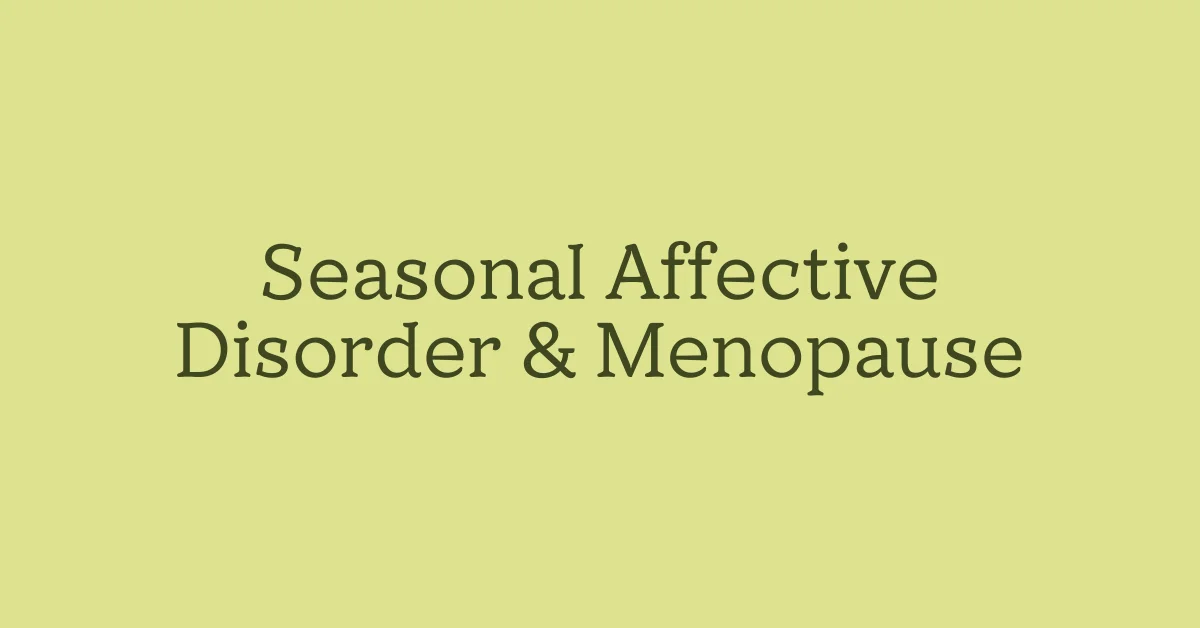Can Seasonal Affective Disorder Make Menopause Worse?

Seasonal changes can influence more than just daily routines. For many women, the colder, darker months bring on Seasonal Affective Disorder (SAD), a form of depression linked to reduced sunlight exposure.
At the same time, menopause introduces its own set of physical and emotional challenges, ranging from hot flashes to disrupted sleep and mood fluctuations.
When these two experiences overlap, the result can feel overwhelming. Women often seek out lifestyle adjustments, therapeutic options, and supplementary support, such as MENO menopause supplements, to help ease the transition.
This article explores how SAD and menopause intersect, whether one can intensify the other, and practical steps for managing both.
What Is Seasonal Affective Disorder (SAD)?
Seasonal Affective Disorder (SAD) is a mood disorder that typically occurs during the fall and winter months when daylight hours are shorter. Its symptoms go beyond the “winter blues” and often include persistent fatigue, difficulty concentrating, oversleeping, cravings for carbohydrates, and a general sense of low mood.
Scientists believe that reduced sunlight plays a key role, disrupting the body’s circadian rhythm and lowering serotonin levels, which can affect mood stability. At the same time, melatonin production increases, often leading to greater feelings of sleepiness.
While many people experience mild sluggishness during seasonal shifts, SAD can significantly impair quality of life. Understanding how SAD works provides important context for exploring its potential impact on women navigating the physical and emotional transitions of menopause.
How Does Menopause Affect Mental and Physical Health?
Menopause marks the end of menstrual cycles, typically occurring in the late forties or early fifties. It is driven by a natural decline in reproductive hormones, especially estrogen and progesterone.
These hormonal changes are known to cause a wide range of symptoms, including hot flashes, night sweats, irregular sleep patterns, mood swings, and decreased energy levels.
Beyond the physical shifts, menopause can influence emotional health, with many women reporting increased stress, irritability, or feelings of sadness. Sleep disturbances, in particular, often amplify these challenges by reducing resilience during the day.
While menopause is a normal life stage, its effects on mood and energy make it a period of heightened vulnerability. This vulnerability may explain why SAD can become a complicating factor, intensifying symptoms that already strain quality of life.
Where Do SAD and Menopause Intersect?
When SAD and menopause occur together, their overlapping symptoms can be difficult to separate. Both conditions are associated with fatigue, irritability, disrupted sleep, and lowered mood.
For women already experiencing hot flashes and night sweats at night, SAD-related oversleeping or restless sleep may worsen the sense of exhaustion.
Mood swings connected to hormone changes can also become more pronounced when layered with the depressive symptoms of SAD. The similarities can make it challenging to determine whether a low mood stems from seasonal changes, hormonal shifts, or both. This overlap can lead to frustration, particularly if the right treatment path is unclear.
Recognizing the shared symptoms of SAD and menopause is a first step in seeking effective solutions because it allows healthcare providers and individuals to address both influences simultaneously rather than treating them in isolation.
Can SAD Make Menopause Worse?
Research and clinical observations suggest that SAD can indeed intensify the challenges of menopause. While menopause itself does not cause depression, the hormonal changes can affect neurotransmitters that regulate mood.
Reduced sunlight during the fall and winter can add another layer of disruption, further lowering serotonin and destabilizing circadian rhythms. Together, these shifts can create a feedback loop that magnifies mood swings, fatigue, and sleep disturbances.
Women living in northern regions or areas with long, dark winters may be especially vulnerable. Similarly, those with a prior history of depression or anxiety may experience more severe symptoms when SAD and menopause overlap.
It is important to note that SAD does not create menopause symptoms, but it can heighten their severity and duration. The result may be a seasonally worsened experience of hot flashes, irritability, and low energy that feels significantly more difficult to manage.
Strategies for Managing Both Conditions
Addressing the combined effects of SAD and menopause requires a thoughtful, multifaceted approach. Light therapy, often referred to as phototherapy, is one of the most common and effective treatments for SAD.
Sitting near a light box that mimics natural sunlight for about 20 to 30 minutes daily can help regulate circadian rhythms and improve mood.
Regular physical activity is also beneficial, particularly when it takes place outdoors. Even limited exposure to daylight can positively influence serotonin production and energy levels. Exercise additionally supports overall cardiovascular health, which becomes increasingly important during and after menopause.
Finding Balance
Seasonal Affective Disorder and menopause share many symptoms, and when they occur together, they can amplify each other in ways that disrupt daily life.
While menopause introduces natural hormonal changes that affect sleep, mood, and energy, the reduced sunlight of fall and winter can compound these struggles by altering brain chemistry and circadian rhythms.
